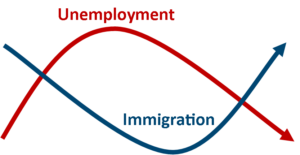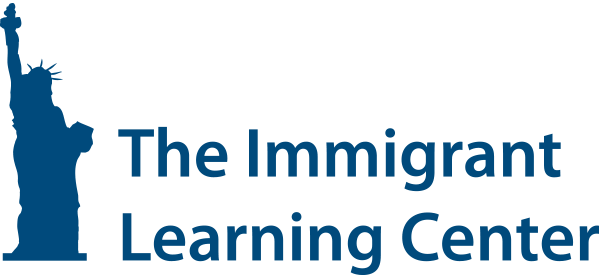
Immigrants are a key part of the U.S. economy in the best and worst of times. Right now, we are facing severe unemployment, stock market plunges and businesses closures due to the COVID-19 epidemic. As the United States struggles to come to terms with the challenges of both a public health and an economic crisis, one segment of the population is already in a unique position to help our recovery: immigrants.
Welcoming immigrants is a time-tested way to ensure resilience and stability as the country moves forward. This was most recently apparent after the Great Recession of 2008 when the presence of foreign-born workers boosted the economy. They can do the same for the pandemic recovery.
Immigrants arrive when they are needed most
 People migrate to take advantage of opportunities. When there are fewer job openings, fewer people decide to uproot their lives and move. During the Great Recession, the number of new arrivals to the country decreased, and resident immigrants experienced higher unemployment than U.S.-born workers. When the economy started to recover, immigrants went back to work filling in important niches in the economy. Because immigrants tend to be more flexible in terms of location and industry, they can be an important ingredient to kick-starting the economy. This is in keeping with research that shows immigrant populations are likely to flock to areas that are in a pattern of economic growth, and immigrant labor is key in maintaining growth rates in U.S. cities. As the Cato Institute says, “Immigrants are heralds of growth, not portents of economic disaster.”
People migrate to take advantage of opportunities. When there are fewer job openings, fewer people decide to uproot their lives and move. During the Great Recession, the number of new arrivals to the country decreased, and resident immigrants experienced higher unemployment than U.S.-born workers. When the economy started to recover, immigrants went back to work filling in important niches in the economy. Because immigrants tend to be more flexible in terms of location and industry, they can be an important ingredient to kick-starting the economy. This is in keeping with research that shows immigrant populations are likely to flock to areas that are in a pattern of economic growth, and immigrant labor is key in maintaining growth rates in U.S. cities. As the Cato Institute says, “Immigrants are heralds of growth, not portents of economic disaster.”
Immigrants are job multipliers
 Despite the historical record, when people are losing jobs they are tempted to call for restrictions on workers entering the country. The lessons from the Great Recession show us that such measures often backfire.
Despite the historical record, when people are losing jobs they are tempted to call for restrictions on workers entering the country. The lessons from the Great Recession show us that such measures often backfire.
With the economy shrinking, the United States capped H1-B work visas at drastically low rates. While it seems that would leave more jobs for U.S.-born workers, New American Economy found that the reverse happened. The result was a shortage of high-skilled workers, which stunted revenue and job growth at a time when it was most needed, particularly in high-tech businesses.
A similar problem occurred in agriculture when the number of foreign-born farm workers decreased. New American Economy’s research shows that billions of dollars in revenue and job growth were lost for farms and related industries such as transportation.
With this in mind, it’s no wonder that the Brookings Institution suggested that increased employment among immigrants may be an indicator of the end of a crisis and the beginning of a recovery. By keeping our doors open to immigrants, the U.S. can position itself for a quicker recovery and the chance to expand the economy in new directions.
We need immigrants now more than ever
 The United States is not just in the midst of an economic crisis, we are also the global epicenter of the deadliest pandemic in a century. Immigrant workers are at the forefront of the fight against COVID-19. Essential fields such as health care, sanitation, agriculture, transportation and food services are heavily reliant on immigrant workers. They are putting themselves at risk to help us all get through this crisis. There are an estimated 263,000 additional immigrant health care professionals who could be activated if the U.S. government can find a way to recognize their credentials. If this crisis continues much longer, we may need them.
The United States is not just in the midst of an economic crisis, we are also the global epicenter of the deadliest pandemic in a century. Immigrant workers are at the forefront of the fight against COVID-19. Essential fields such as health care, sanitation, agriculture, transportation and food services are heavily reliant on immigrant workers. They are putting themselves at risk to help us all get through this crisis. There are an estimated 263,000 additional immigrant health care professionals who could be activated if the U.S. government can find a way to recognize their credentials. If this crisis continues much longer, we may need them.
The country’s reliance on immigrants has never been as clear as it is in this moment, and not just as workers. Immigrants are also business owners. In fact, nearly one third of new businesses in the United States are founded by immigrants. Many of these are “Main Street” business, exactly the kind of small businesses that are hurt most by this crisis. That hasn’t stopped some of these immigrant business owners from pitching in. There are restaurants serving free meals and nail salons making face masks. Both during and after this crisis, keeping the door open to foreign innovators and investors will be crucial to getting the country back to work.
The Center for American Progress (CAP) noted that such moments of crisis provide opportunities to see where economic systems are working well and where they must be reformed. During the aftermath of the Great Recession, CAP researchers suggested the country seize upon the chance to address the ways in which the immigration system impeded economic growth. The opportunity to plan for a recovery that helps both old and new Americans grow together is possible, and the country has the data to determine best practices for moving forward. In the midst of such difficult times, the United States can remember the value of diverse population and workforce and move towards unity.
